Beneficial Garden Insects, the Second Line of Defense Against Garden Pests
Beneficial garden insects are the second line of defense against garden insect pests.
|
Catmint Flowers © Steve Masley Click IMAGE to Enlarge |
In organic gardens, plant vigor is the first line of defense against pests, but when plants are stressed from extreme temperatures, drought, or nutrient deficiencies, pests key in on the weakened plants. That's when beneficial insects move in.
In a healthy organic garden, diverse species act as checks and balances on population surges of any individual pest. See Attracting Beneficial Insects for strategies to attract and sustain populations of beneficial insects.
This page focuses on the role beneficial insects play in natural garden pest control. There are 3 main types of beneficial garden insects:
- Pollinators, in their search for nectar, transfer pollen between the flowers of fruiting plants, fertilizing the seeds. Pollinators are critical to tree crops, berries, and row crops like peppers, eggplants, squash, melons, and cucumbers.
- Parasitic Wasps, a.k.a. “parasitoids" control garden pests at low population densities, keeping them from getting out of hand.
- Predatory Insects like ladybugs, spiders, and praying mantises, are key to controlling garden pests that do get out of hand.
Pollinators
|
Parasitic Wasps
|
Predatory Insects
The One-Two Punch
Pollinators
|
Basil Flower © Steve Masley Click IMAGE to Enlarge |
Pollinators are among the most important beneficial garden insects. They do nothing to control garden pests, but without them, tree fruit, berries, and row crops like peppers, squash, and melons can’t set fruit.
Crops like tomatoes, beans, and peas, can self-pollinate by wind action, but yields and quality of fruit are much better with the cross-pollination provided by honeybees and other pollinators.
European honey bees are the predominant farm and garden pollinators. Tree fruit and berries require insect pollinators, and one third of vegetable crops depend on European honey bees for pollination.
Other pollinators include orchard mason bees, bumblebees, and other native bees.
|
© Steve Masley…Click IMAGE to Enlarge |
Butterflies, moths, flies, beetles, ants, and birds can also act as pollinators, although they’re not significant pollinators of vegetables. In most agricultural situations, European honeybees will outcompete native pollinators.
In recent years, European honey bee populations have plummeted. The first hit came from Varroa mites, but now, the big problem is CCD—Colony Collapse Disorder. In 2008-9, some commercial bee keepers lost half their hives, and losses of 20-30% were common.
In Colony Collapse Disorder, foraging bees fly out in the morning, and never return. The hive languishes and dies.
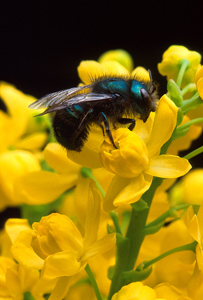
|
|
Barberry Photo by Jack Dykinga © Jack Dykinga…Click IMAGE to Enlarge |
No one really knows the root causes of CCD, but theories abound. Some blame pesticides, some, the stresses of being trucked from one side of the country to the other, first pollinating almonds in California, then peaches in Georgia. Some blame the absence of “down time" for the hives, or a lack of diversity in nectar and pollen sources.
For an overview of pollinator issues and CCD, see Bees are Busier than Ever as Disease Besieges Colonies
Whatever the threats to pollinators, there are things organic gardeners can do to encourage pollinators—both European honey bees and native pollinators. Pollination is too critical for us to rely on one species, even if that species is the most efficient.
We should hedge our bets, and do everything we can to encourage populations of alternate pollinators.
See Attracting Pollinators for strategies to attract pollinators and build up their populations over time.
Pollinators
|
Parasitic Wasps
|
Predatory Insects
The One-Two Punch
|
Attracting Beneficial Insects
Parasitic Wasps
|
© Steve Masley…Click IMAGE to Enlarge |
Parasitic Wasps (parasitoids) are the first check on insect pests. They’re critical because they operate at low population densities, before pests get out of hand. They can help prevent pest populations from exploding even when food is abundant.
Larger wasps, important garden predators, carry prey insects back to the nest, and cache them near their eggs. (This had to be the original inspiration for the movie “Alien").
Unlike their larger cousins, parasitoid wasps find their prey in the field, and lay their eggs in—or on—the host insect.
Parasitoids patrol the undersides of leaves and gaps between flowers, searching for hosts to lay eggs in; they go where no gardener can go, attracted by host pheromones and visual cues.
A single Trichogramma female can lay 100 eggs in aphids or the eggs of caterpillars. Larger parasitoids like Chalcidid and Bracconid wasps attack insects at the larval stage.
Parasites rarely kill their hosts, while parasitoid wasps always kill their hosts. Entomologists use the term “parasitoid", rather than “parasitic", to refer to these beneficial garden insects.

|
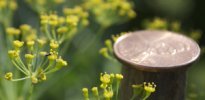
|
|
|
Egg parasitoids are among the most important beneficial garden insects. These tiny, gnat-sized wasps have a wingspan of 1 mm—about the size of Lincoln’s beard on a penny.
Some have stingers, but they can’t penetrate human skin, even if they ever had any inclination to sting you.
What they’re more inclined to sting are the eggs of pest insects, and aphids.
If you turn a leaf over and see aphids, you’ll likely see some brown aphid “mummies", aphids that have been parasitized. A parasitoid wasp is developing inside the husk of the aphid’s exoskeleton. If you see a hole at one end, the parasitoid has already emerged.
|
© Steve Masley…Click IMAGE to Enlarge |
Other, larger parasitoids can be 1/4-3/8" (6-9mm) long, but even when you’re looking for them, they’re elusive.
There are a staggering number of species of parasitoid wasps. According to Townes (1971) ‘There are more species of Ichneumonidae than all vertebrate animals combined.’ In other words, more than all the mammals, birds, reptiles, amphibians, and fish.
And the Ichneumonidae are only one branch of the Parasitic Hymenoptera.
Parasitoids have a profound effect on garden pest populations, but they’re extremely susceptible to pesticides, herbicides, or any chemical spray. They’re the first insects to die whenever sprays are used. Even non-toxic mists and dusts can be lethal to a gnat-sized insect.
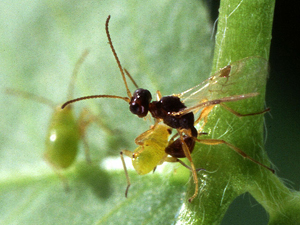
|
|
Plant Bug Nymph Photo by Scott Bauer © Scott Bauer…Click IMAGE to Enlarge |
Parasitoids rarely attack mature insects, but they attack every stage of immature insect, from egg through each larval instar to pupae. Different parasitoids attack different stages, and together they’re known as parasitoid guilds.
Parasitoids sometimes pierce the exoskeleton of a pest and sip hemolymph for proteins to fuel egg development. Later, after the eggs have formed, they’ll return to deposit an egg in or on the same pest.
Some parasitoid wasps use germ warfare. They inject polydnaviruses into the host, along with their eggs. The polydnaviruses immobilize the host’s immune system, allowing the parasitoid larvae to develop.
|
Cocoons Photo Courtesy of Linda Casey, (with thanks) © Linda Casey Click IMAGE to Enlarge |
The parasitoid larvae devour non-essential organs and tissues first, waiting till just before pupating to eat the essential organs that kill the host.
The parasitic hymenoptera aren’t the only beneficial garden insects that act as parasitoids. Tachinid Flies and Phorid Flies come from a completely different insect family (Diptera), but are equally gruesome. Phorid flies lay their eggs on the necks of ants, and the larvae form a ring-shaped parasite around the ant’s neck. The parasite penetrates the exoskeleton, and draws ant hemolymph to fuel its growth.
As it grows, it squeezes the ant’s neck, eventually popping the head off. The larva then makes a meal of the ant’s brain, and crawls inside the head capsule to pupate.
The presence of phorid flies limits the size of ant hills. When phorid flies are present, the further the ants range from the hive, the greater their exposure to the parasitoid. When phorid flies are present, every ant can’t be a forager. Some have to watch the sky to defend the others, and when they’re watching, they can’t be gathering food for the hive.
As beneficial garden insects, parasitoids tend to be host-specific. They prey on a particular garden insect pest, or a particular life stage in a small number of similar garden pests.
See Attracting Parasitic Wasps for strategies to attract parasitic wasps and build up their populations over time.
Pollinators
|
Parasitic Wasps
|
Predatory Insects
The One-Two Punch
|
Attracting Beneficial Insects
Predatory Insects
|
for Hapless Pests © Steve Masley …Click IMAGE to Enlarge |
Parasitoid wasps aren't the only beneficial garden insects for controlling pests. Predatory insects also play a role.
Predator populations rise in response to increases in prey populations, so they’re the cleanup crew when things get out of hand.
Garden insect predators include beetles, centipedes, lacewings, ladybugs, wasps, syrphid flies, spiders, robber flies, dragonflies, and praying mantises.
Because predators respond to prey populations, there's often a time lag between a surge in pest insects, and the arrival of predatory insects. If the predators arrive too soon, and there's not enough prey, they either starve, or move on to find another food source.
Sometimes, you just have to be patient, and wait for beneficial garden insects like predators to do their job.
Every spring, the buds on my 'Seven Sisters' rose would be covered with rust-colored aphids. I could mix up a soap spray to kill them, but if I just waited a couple more days, soldier beetles would move in from the field at the edge of the garden, and the next day, the only sign of aphids would be whispy white mouthparts left in the buds, after the soldier beetles ate away all the bodies.
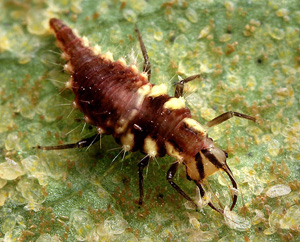
|
|
Whitefly Nymphs Photo by Jack Dykinga © Jack Dykinga…Click IMAGE to Enlarge |
Unlike parasitoids, most predators are not prey-specific—they eat anything smaller or slower than themselves—sometimes including smaller members of their own species. They will usually shift to whatever prey species is most abundant.
This makes them an excellent failsafe if garden pests escape the gauntlet of parasitoids. As beneficial garden insects, larval forms are often more voracious than adults.
Pollinators
|
Parasitic Wasps
|
Predatory Insects
The One-Two Punch
|
Attracting Beneficial Insects
Parasitoids and Predators Work Together
If parasitoids are the first responders, predators are the National Guard.
Under normal circumstances, parasitoids can check surges in pest populations before they get out of hand. Sometimes, environmental extremes (like drought) stress plants, so they're more susceptible to pests, and pest numbers skyrocket.
At this point, the predators move in.
The photo on the left shows two important beneficial garden insects, a ladybug and a soldier beetle, probing the crevices of a tatsoi plant in my window box for aphids.
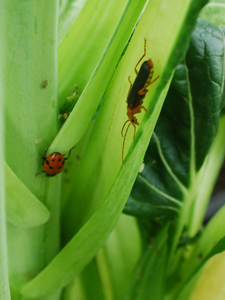 |
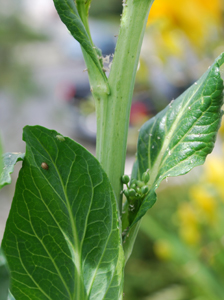
|
|
Click IMAGES to Enlarge | |
The photo on the right shows a parasitized aphid (brown sphere) and a live aphid (green sphere on the edge of the leaf). The white flecks on the other leaf are the mouthparts of aphids, all that’s left after the predators come through. Curiously, aphid predators ignore parasitized aphids.
See Attracting Insect Predators for strategies to attract and sustain populations of insect predators and other beneficial garden insects.
Top of Beneficial Garden Insects
|
Natural Garden Pest Control
Pollinators
|
Parasitic Wasps
|
Predatory Insects
The One-Two Punch
|
Attracting Beneficial Insects
Copyright © 2009-2025, by Steve Masley, Grow-it-Organically.com
All rights reserved
HOME | About Us | Contact Us | Privacy
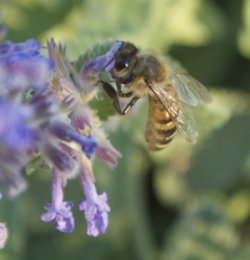

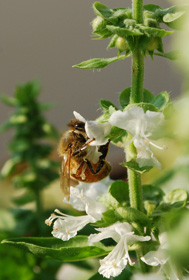
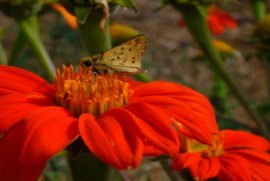
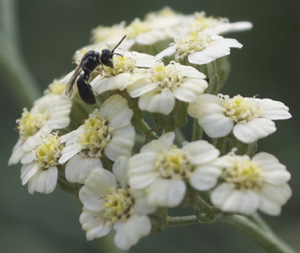
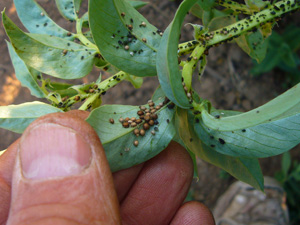
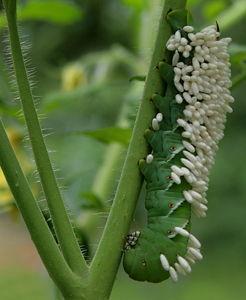
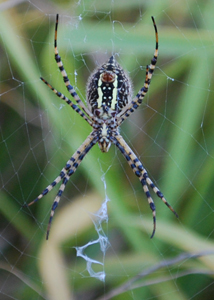
New! Comments
Have a question or comment about what you just read? Leave me a comment in the box below.